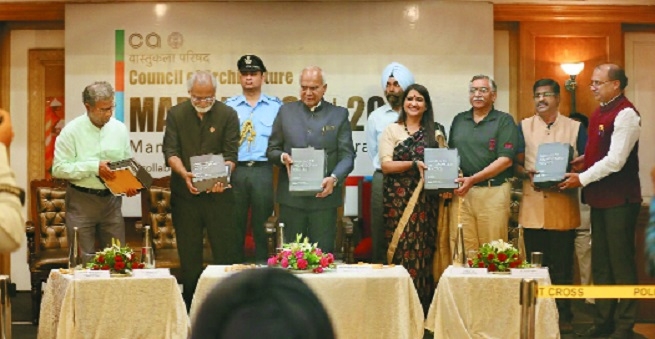Governor Purohit launches COA’s Manual of Architectural Practice
| Date :31-Aug-2022 |

(3rd L) Governor of Punjab and Administrator of Chandigarh Banwarilal Purohit launching Manual of Architectural Practice. (L) Principal Secretary to Governor J M Balamurugan, (2nd L) President of COA Habeeb Khan, (4th L) Vice President Sapna, (3rd R) ex-Vice President Vijay Uppal, Executive Committee Members of COA (2nd R) Vaitanadin and (R) Nandlal Chandel.
Staff Reporter :
CHANDIGARH, GOVERNOR of Punjab and Administrator of Chandigarh, Banwarilal Purohit has launched the Manual of Architectural Practice prescribed by the Council of Architecture (COA) in a grand ceremony held recently in Hotel Mountview, Chandigarh in the presence of President of COA Habeeb Khan, Vice President of COA Sapna, former Vice President of COA Vijay Uppal, Principal Secretary to Governor of Punjab J M Balamurugan. The programme was attended by Executive Committee members of the COA, office-bearers and members of Indian Institute of Architects (IIA) apart from eminent practicing architects, heads of schools of architecture, academicians and students of architectural institutions.
The Council, after having more than one-year long discussions and consultations with concerned stakeholders, has come out with Manual of Architectural Practice to replace the existing conditions of engagement and scale of charges prescribed under Architects (Professional Conduct) Regulations, 1989. The Volume 1 of Manual has guidelines for architectural practice those set the base for all further discussions. It outlines how the profession emerged, how the practice of architecture was set up and regularised, who architects are, what all they do, and how and what services they provide. The Architects Act 1972 and the Code of Professional Conduct have also been recorded in the document. The various ways in which a potential client could discover, define, gauge, compare, and finally select the most appropriate Architect that fits the requirements of their specific project is discussed in detail in Volume 2. In Volume 2, the guidelines for Engagement of Architects and Code for Competitions are given. Ready templates and various formats are also provided for conducting different types of competitions: Ideas, Open, Invited. Guidelines for Architectural Contracts go on to present definitions and descriptions of various Contracts for Professional Services that are required to be entered into by the architect with a client are mentioned in Volume 3.
The Volume presents Contracts for three scales and complexities of projects Concise, Standard and Comprehensive, covering the widest range of professional works being assigned. With a Contract in hand, Volume 4 presents thorough and detailed processes and methods for deriving and calculating the value of the architect’s professional consultancy services, as guidelines for architectural services and fees. Simple, clear and easy-to-use formats are also provided for fees to be calculated through four different methods: Lumpsum, Percentage, Unit Area and Man-hours. The COA has also prescribed the Fee Band for various services. Volume 5 is a general advisory to all Architects on the wide and varied aspects of setting up and guidelines for the management of firms. It also covers the Practicing Architect’s responsibility and commitment to internships - which form an integral part of the CoA’s endeavor to link architectural students with the realities of actual professional practice. The event also witnessed release of Council’s Guidelines on ‘Role of Architect in Public Service’ with an objective to streamline cadre strength of Architects in Government sector and also to rationalise the role and responsibilities or Architects in construction of public buildings.
